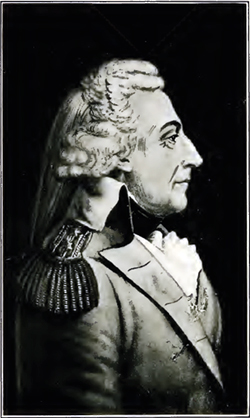| Welcome |
| About Us |
| History of Bloomfield |
| Museum |
| Membership |
| Maps |
| Photo Galleries |
| Newsletter Archive |
| Video Archive |
| Resources |
|
Bloomfield, New Jersey - A Brief History | |
|
Interesting Facts about Bloomfield
|
 General Joseph Bloomfield Photo from Bloomfield Old and New, 1912 |
|
17th and 18th Centuries The area now known as Bloomfield was a part of Newark in 1666 when that town was settled. The land had been bought from the Yantecaw, a subtribe of the Lenni-Lenape Indians. English settlers came from Connecticut to the southern end of town, and Dutch settlers from the Hudson River Valley set up farms in the Stone House Plains section, now Brookdale. The earliest roads followed Indian trails. The Old Road to Newark (now Franklin Street), the Road to Newtown and Second River (now Belleville Avenue) and the Road to Cranetown (now Montclair) became important routes.
The three waterways, Second River, Third River and Toney’s Brook, were valuable sources of power for the first industries - sawmills and gristmills. Paper mills and tanneries followed. Sandstone was quarried and exported to New York City as early as 1765 for the construction of brownstone houses.
The settlers established the first school in 1758. It was public but not free, being open to pupils who could afford to pay a small tuition fee. During the Revolutionary War, no fighting occurred within the limits of the present township, but Bloomfield sons fought in New Jersey engagements. The area did experience foraging raids by British and Hessian troops. Patriots entertained George Washington on several occasions. In 1796, the congregation of Old First Church (now Bloomfield Presbyterian Church on the Green) was formed. It honored the Revolutionary War General, Joseph Bloomfield, by naming the newly formed parish after him - the Presbyterian Society of Bloomfield. The beautiful church building which was started in 1797 is still standing at the northern end of the Green. The same year, the Green was officially purchased for $200.00, although it had been used as a military training field and parade ground since 1775. It was placed on the National Register of Historic Places in 1978. | |
|
Joseph Bloomfield (1753-1823) Major, Revolutionary War — 1176-1778
Joseph Bloomfield was born on October 18, 1753 in Woodbridge, Middlesex County, the son of Dr. Moses Bloomfield and Sarah Ogden. Moses Bloomfield was a surgeon and a leader in the anti-slavery abolitionist movement, hosting meetings in his home. Joseph was educated at Rev. Enoch Green's school in Deerfield, Cumberland County, New Jersey, where Rev. Green was pastor of the Presbyterian Church in Deerfield. He was a lifelong activist for the abolition of slavery.
Bloomfield studied law, was admitted to the bar in 1775 and commenced a law practice in Bridgeton, New Jersey. He entered the Revolutionary Army as Captain of the Third New Jersey Regiment on February 9, 1776, attained the rank of Major on November 28, 1776, and also was appointed judge advocate of the Northern Army during the same month. He was wounded at the Battle of Brandywine, September 1777. He resigned from the Revolutionary Army on October 28, 1778, having been elected Clerk of the New Jersey Assembly the day before.
Bloomfield married Mary McIlvaine (1752-1818), daughter of Dr. William McIlvaine, of Burlington. | |
90 Broad Street
Bloomfield, NJ 07003
973-743-8844
info@hsob.org
| Museum Hours |
| Wednesday and Saturday: 11:00am - 2:00pm and by appointment |